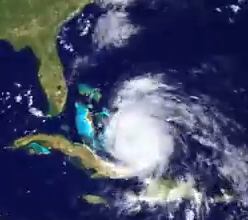I was listening to NPR this morning as I got ready for work and during the headlines at the top of the hour heard a short story about communities preparing for Hurricane Irene. It featured a quick actuality from a sheriff in South Carolina saying that a battery operated radio will be a vital tool to stay informed when Irene’s force hits. To me that advice sounds obvious, and not just because I’m such a radio enthusiast. Growing up on the East Coast it seems like I always heard about having a radio and plenty of batteries on hand whenever a severe storm threatened. As well, when I moved to the Midwest in the 1990s having a portable radio with fresh batteries on hand was advised to be ready for a tornado.
However, now that we rely so heavily on cell phones and other networked devices it’s easy to forget that they’re much more susceptible to failure during power outages brought on by natural disasters. Even if your mobile phone still has battery life, the closest cell tower might not. No power in the house probably means no power for your cable modem or wireless router, either. Of course, radio transmitters also require power, but many broadcasters maintain backup generators so that they can remain on air during blackouts and emergencies.
Unlike other natural disasters, a hurricane can be predicted days before it hits, giving responsible broadcasters an opportunity to prepare. The radio industry site All Access talked to several stations along the coast about their plans. One station group in Norfolk Beach, VA said it is sure to have accommodations for staff and their families so they can remain working on-air. Another station in South Carolina said that it’s prepared to “all hands on deck 24/7,” along with airing simulcasts from an affiliated TV station. Going “24/7” is now exceptional for the majority of commercial stations, since most are automated at least part of the day, especially overnights.
Even if not every radio station is able to remain on air during a severe storm, the odds are high that at least one will keep broadcasting. Very powerful stations further inland with broadcast ranges of 100 miles or more can provide vital emergency info to coastal areas that are harder hit.
Luckily a perfectly capable portable AM/FM radio that runs on inexpensive AA batteries can still be had for under $20 at discount and department stores, as well as major drug store chains. It’s an even better idea to buy one of the emergency radios that can be powered by a crank or solar energy. Then you can stay reliably tuned in even if you run out of batteries.
Outside the broadcast band, for nearly a century amateur radio operators have provided vital assistance to communities and civil authorities during disasters. A Wall Street Journal story notes that, “Maine has squads of amateur-radio clubs statewide ready to provide back-up communication if cell towers topple.”
Since 1965 the Hurricane Watch Net has organized radio amateurs to operate and provide communication lines during every hurricane that threatens land in the Atlantic, Caribbean and Gulf of Mexico. Participating HWN operators transmit and relay information on 14.325 MHz, asking other operators not to use that frequency when an alert is activated. In particular HWN provides important weather info, like local wind speed, to the National Hurricane Center, which monitors that frequency.
Fundamentally, radio is a comparatively inexpensive, robust and proven communications technology. Having internet and digital mobile communications will undoubtedly provide great assistance to first responders and average people during this hurricane. But when the power is out for more than a few hours that radio will provide important communication and solace. When wired lines are cut by falling trees, wireless radio communications will still transmit through the air. I’m certainly glad that radio is still a viable, living technology.




